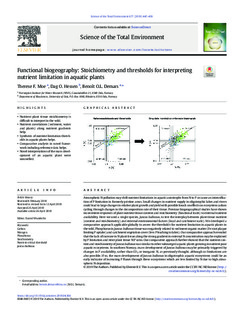| dc.contributor.author | Moe, Therese Fosholt | |
| dc.contributor.author | Hessen, Dag Olav | |
| dc.contributor.author | Demars, Benoît Olivier Laurent | |
| dc.date.accessioned | 2019-10-08T09:42:22Z | |
| dc.date.available | 2019-10-08T09:42:22Z | |
| dc.date.created | 2019-07-02T13:32:24Z | |
| dc.date.issued | 2019 | |
| dc.identifier.citation | Science of the Total Environment. 2019, 677, 447-455. | nb_NO |
| dc.identifier.issn | 0048-9697 | |
| dc.identifier.uri | http://hdl.handle.net/11250/2620829 | |
| dc.description.abstract | Atmospheric N pollution may shift nutrient limitations in aquatic autotrophs from N to P or cause an intensification of P limitation in formerly pristine areas. Small changes in nutrient supply in oligotrophic lakes and rivers could lead to large changes in relative plant growth and yield with possible knock on effects on ecosystem carbon cycling through changes in the decomposition rate of their tissue. Previous biogeographical studies have shown inconsistent responses of plant nutrient tissue content and stoichiometry (functional traits) to external nutrient availability. Here we used a single species, Juncus bulbosus, to test the interplay between plant tissue nutrient (content and stoichiometry) and external environmental factors (local and catchment scale). We developed a comparative approach applicable globally to assess the thresholds for nutrient limitation in aquatic plants in the wild. Phosphorus in Juncus bulbosus tissue was negatively related to sediment organic matter (Fe root plaque limiting P uptake) and catchment vegetation cover (less P leaching to lakes). Our comparative approach revealed that the lack of increase in N plant tissue along the strong gradient in external N concentration may be explained by P limitation and strict plant tissue N:P ratio. Our comparative approach further showed that the nutrient content and stoichiometry of Juncus bulbosus was similar to other submerged aquatic plants growing in nutrient poor aquatic ecosystems. In southern Norway, mass development of Juncus bulbosus may be primarily triggered by changes in P availability, rather than CO2 or inorganic N, as previously thought, although co-limitations are also possible. If so, the mass development of Juncus bulbosus in oligotrophic aquatic ecosystems could be an early indicator of increasing P fluxes through these ecosystems which are less limited by N due to high atmospheric N deposition. | nb_NO |
| dc.language.iso | eng | nb_NO |
| dc.publisher | Elsevier | nb_NO |
| dc.rights | Attribution-NonCommercial-NoDerivatives 4.0 Internasjonal | * |
| dc.rights.uri | http://creativecommons.org/licenses/by-nc-nd/4.0/deed.no | * |
| dc.title | Functional biogeography: Stoichiometry and thresholds for interpreting nutrient limitation in aquatic plants | nb_NO |
| dc.type | Journal article | nb_NO |
| dc.type | Peer reviewed | nb_NO |
| dc.description.version | publishedVersion | nb_NO |
| dc.rights.holder | © 2019 The Authors | nb_NO |
| dc.source.pagenumber | 447-455 | nb_NO |
| dc.source.volume | 677 | nb_NO |
| dc.source.journal | Science of the Total Environment | nb_NO |
| dc.identifier.doi | 10.1016/j.scitotenv.2019.04.366 | |
| dc.identifier.cristin | 1709401 | |
| cristin.unitcode | 7464,30,19,0 | |
| cristin.unitname | Ferskvannsøkologi | |
| cristin.ispublished | true | |
| cristin.fulltext | original | |
| cristin.qualitycode | 2 | |

